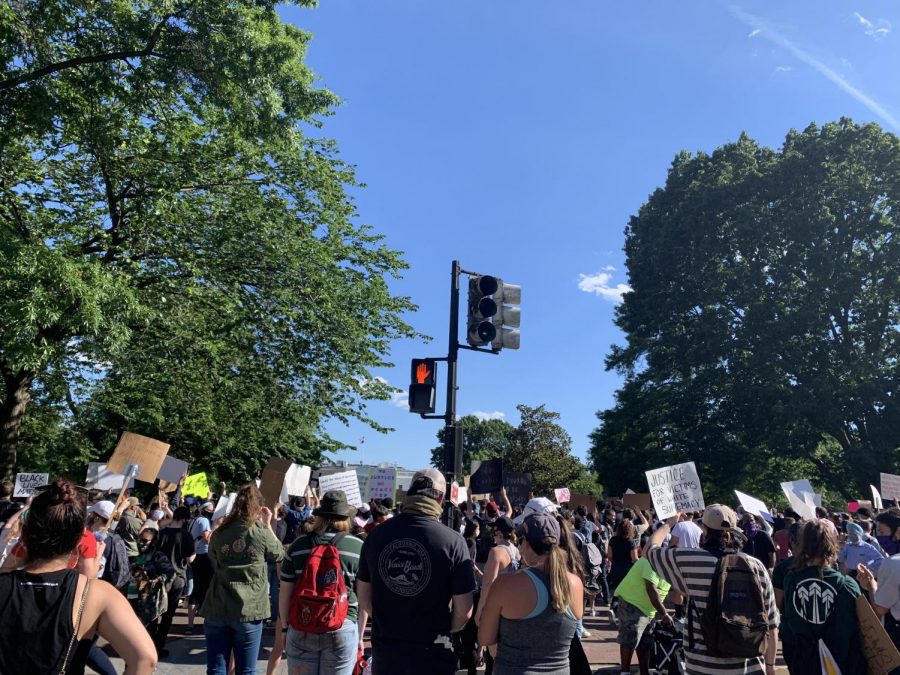Op-ed: America’s supposed commitment to nonviolence rings hollow
On June 1, protestors demanded justice outside of the White House.
September 8, 2020
“Congratulations, you just solved racism.” Sardonic comments in this vein abounded on social media Aug. 26 when the Milwaukee Bucks refused to participate in that night’s playoff game against the Orlando Magic. The boycott, soon followed by the rest of the NBA, came in response to the outcry over a police officer in Kenosha, Wisconsin, shooting Jacob Blake seven times in the back. Right-wing commentators pounced on the display of solidarity, casting Black players as entitled millionaires whose wealthy status was evidence against the existence of racial inequality. The president of the United States mocked the league, stating, “They’ve become like a political organization. … I don’t think that’s a good thing for sports or for the country.” Although Laura Ingraham did not explicitly say “shut up and dribble” as she did in the past, the subtext remains.
Like many Black Americans, I am not surprised. This is the country’s predictable response to dissent. However, I must confess that even I am astounded by the ability of the American lie to hold up under its own staggering contradictions, including this latest one. This lie is the belief, supposedly rooted in our system, that peaceful, nonviolent, comfortable protest is a legitimate means to addressing a grievance.
As I sit here in Boston, I am constantly surrounded by the history that weighs down this lie. Every year as a schoolboy, I was regaled with tales of the American Revolution, an arduous, righteous struggle against the oppressive British government, an ode to the idea that some injustices are so great that all means must be taken up to redress them. But less than two miles from my dorm lies the Boston Common, where a Boston mob tarred and feathered British tax collector John Malcolm. This was not an isolated incident. Yet I submit to you, that in no textbook have I ever seen it suggested that the violence in this act, and the very nature of the Revolutionary War, took away from its goals and morality. But the instant a crowd gets too loud, or the word “revolution” is spoken regarding racial equality, the current Black Lives Matter movement is deemed radical and a threat to the American way of life. Though the constant war against Black people for 400 years constitutes nothing other than violence, the response is apparently shocking.
Although, I suppose the purveyors of the notion that equality threatens America’s way of life are actually correct, for this contradiction has been built into the very fabric of our existence. America as it is could not exist otherwise. Our educators cannot continue to tell us that the nonviolence of the Civil Rights movement in the 20th century is what guaranteed its success, a perspective that ignores the fundamental emancipatory fable of the country. This double standard has been the source of ire of Black activists from Douglas to Baldwin to Malcolm X.
Unlike Black Americans, white Americans are protected by the law, but not bound by it. They can call upon the law to protect their right to be armed when protesting state quarantines and mask mandates, but are not bound by curfews and police ordinances. When police feel their interests align with those of protestors, these so-called “law-abiding citizens” are certainly not shot with rubber bullets, doused with tear gas and beaten with clubs even if they do break protocol. However, Black people, or those protesting for their causes, are bound by the law for their actions of dissent, and the protest itself stems from the failure of the law to ever provide them protection or justice at the hands of the police. It is a monument to America’s commitment to white supremacy — one that holds that Black people do not have the same recourse to address grievance as whites.
The violent response to civil disobedience is clear evidence of how contemptuously the state views “peaceful protest.” On June 1, President Donald J. Trump and Attorney General Bill Barr savagely ordered an attack on protesters in Lafayette Square, with tear gas and rubber bullets, for a photo op of Trump holding a Bible at the church located in front of the White House. Reporters were assaulted for documenting the atrocities; water bottles were slashed by vindictive police.
As officers on horseback strode down the street to the tune of screams, the scene seemed ripped out of history itself, a parallel to the violence in the streets of Birmingham, Selma and other southern cities in the ‘50s and ‘60s. Even with flesh ripped apart by police canines, bodies blasted into the street by fire hoses, clothes torn off, and ribs and bones cracked by batons, the black-and-white still images of those moments never fully capture the depths of human suffering. How can “nonviolence” ever lead to meaningful change in a nation whose default response never fails to include barbarism? It is a testament to America’s commitment to white supremacy — one that holds that Black people must allow their bodies to be broken in the name of “nonviolence.”
So I say unrest doesn’t shock me. Anger does not leave me with any amazement. And yes, I am not taken aback by the violence present in our country today, which is merely the continuation of America’s never-ending internal war on Black people. When a white 17-year-old crosses state lines, and murders two people, he is applauded by the very people who scoff at the notion of violence – I am not surprised. For this is America, acting in the only thing it knows.
Noah Colbert is a first-year mathematics major. He can be reached at colbert.n@northeastern.edu.







